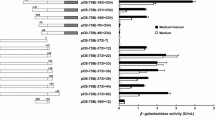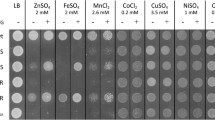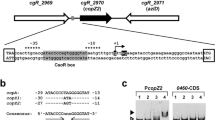Abstract
In this study, oligonucleotide-directed site-specific mutagenesis was used to change the consensus sequences of the LexA binding motifs in either one of the two SOS-boxes of the ColE7 operon. The results indicated that both mutants produced larger amounts of colicin than cells harboring the wild-type ColE7 plasmid. This finding would imply that two biologically functional SOS boxes exist in the ColE7 operon. In the non-induced state, no lysis of cells harboring wild-type plasmids occurred at 37°C, whereas, cells harboring recombinant plasmids containing either one of the mutated SOS boxes underwent lysis within 100 min under the same conditions. This result indicated that adaptation of two SOS boxes of the ColE operon would obviously tightly control the expression of ColE operons. In such a way that it may prevent excessive expression of the lysis (cel) gene, thus safeguard the host cells from being lysed in ordinary living conditions.
Similar content being viewed by others
References
Chak KF, James R (1985) Analysis of the promoters for the two immunity genes present in the ColE3-CA38 plasmid using two new promoter probe vectors. Nucleic Acids Res 13:2519–2531
Cole ST, Saint-Joanis B, Pugsley AP (1985) Molecular characterisation of the colicin E2 operon and identification of its products. Mol Gen Genet 198:465–475
Craig NL, Roberts JW (1980)E. coli recA protein-directed cleavage of phageλ repressor requires polynucleotide. Nature 283:26–30
Eaton T, James R (1989) Complete nucleotide sequence of the colicin E9 (ceal) gene. Nucleic Acids Res 17:1761–1761
Ebina Y, Kishi F, Miki T, Kagamiyama H, Nakazawa T, Nakazawa A (1981) The nucleotide sequence surrounding the promoter region of colicin E1 gene. Gene 15:119–126
Ebina Y, Takahara Y, Kishi F, Nakazawa A (1983) LexA protein is a repressor of the colicin E1 gene. J Biol Chem 258:13258–13261
Fredericq P (1949) Sur la résistance croisée entre colicine E et bacteriophage II. C R Soc Biol (Paris) 143:1011–1013
Higuchi R (1990) Recombinant PCR. In: Innis MA, Gelfand DH, Sninsky JJ, White TJ (eds) PCR protocols. Academic Press, San Diego
Little JW, Mount DW (1982) The SOS regulatory system ofEscherichia coli. Cell 29:11–12
Little JW, Mount DW, Yanisch-Perron CR (1981) PurifiedlexA protein is a repressor of therecA andlexA genes. Proc Natl Acad Sci USA 78:4199–4203
Lloubes R, Granger-Schnarr M, Lazdunski G, Schnarr M (1990) Interaction of a regulatory protein with a DNA target containing two overlapping binding sites. J Biol Chem 266:2303–2312
Masaki H, Ohta T (1985) Colicin E3 and its immunity genes. J Mol Biol 182:217–227
Slilaty SN, Little JW (1987) Lysine-156 and serine-119 are required for LexA repressor cleavage: a possible mechanism. Proc Natl Acad Sci USA 84:3987–3991
Soong BW, Lu FM, Chak KF (1992) Characterization of thecea gene of the ColE7 plasmid. Mol Gen Genet 233:177–183
Walker GC (1984) Mutagenesis and inducible responses to deoxyribonucleic acid damage inEscherichia coli. Microbiol Rev 48:60–93
Wertman KF, Mount DW (1985) Nucleotide sequence binding specificity of the LexA repressor ofEscherichia coli K-12. Bacteriol 163:376–384
Wertman KF, Little JW, Mount DW (1984) Rapid mutational analysis of regulatory loci K-12 using bacteriophage M13. Proc Natl Acad Sci USA 81:3801–3805
Witkin EM (1976) Ultraviolet mutagenesis and inducible DNA repair inEscherichia coli. Bacteriol Rev 40:869–907
Author information
Authors and Affiliations
Additional information
Communicated by W. Goebel
Rights and permissions
About this article
Cite this article
Lu, F.M., Chak, K.F. Two overlapping SOS-boxes in ColE operons are responsible for the viability of cells harboring the Col plasmid. Molec. Gen. Genet. 251, 407–411 (1996). https://doi.org/10.1007/BF02172368
Received:
Accepted:
Issue Date:
DOI: https://doi.org/10.1007/BF02172368




